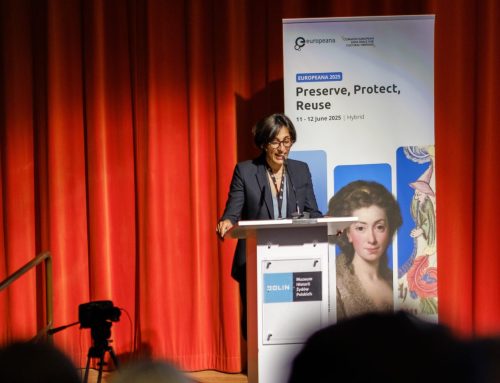On the 15th of September on the international day of Democracy, EuroClio hosted the first session of a series of online workshops entitled A Resilient Promise: Teaching the Fragility of Democracy.
Prof Takis Pappas opened our webinar series on democracy with a compelling keynote lecture on The allure of authoritarianism and on modern populism.
Democracy is something that must be learned at early age
Prof. Pappas commenced with a strong statement that democracy is not something that you can touch or feel. Democracy in his words is something that must be learned at early age. He emphasized that democracy cannot be felt, sensed, or otherwise experienced other than, through formal education and practice from early age, which begins at school. In this respect, he added that teachers are the responsible for teaching young Europeans how to be good democratic citizens.
Furthermore, he noted that there is a challenge how to teach democracy at schools. In this regard, the idea of applied political science helps us to draw lessons from past historical and political experiences to ameliorate our lives in modern societies.
Explaining the concepts
To better understand democracy prof. Pappas highlights some important concepts that we often hear but do not know what exactly the meaning of. He defines democracy as a pluralist political system in which the incumbent party may lose office after free and fair elections.
And what then is liberal democracy? Liberal democracy is a recent phenomenon. According to Prof. Pappas, there was no liberal democracy before 1945. Liberal democracy is a democracy based on the rule of law, i.e., the principles and precepts of political liberalism.
And what is then non-democracy? Non-democracy is a system in which some leaders hold nearly unbounded and arbitrary power even if there are (unfree & unfair) elections.
Modern populism is, in Prof. Pappas taxonomy, a novel political system which is democratic but militates against political liberalism. Hence, democratic illiberalism.
The final important concept is nativism, which is a liberal democratic system meant to protect the interest of native-born citizens against immigrants and other populations. This system is liberal and democratic but prioritize the interest of the natives.
Prof. Pappas clarified the distinction between populists and nativists. When talking about a perceived backsliding of democracy, an association is often made with populists and populism.
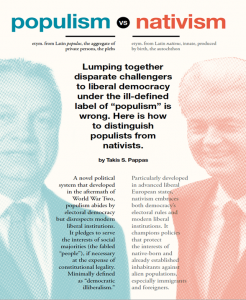
The Difference between populism and nativism, according to Prof. Pappas. Source : https://pappaspopulism.com/populism-nativism-infographic/
Prof. Pappas defines 10 ways to tell populists and nativists apart. The key to distinguishing the two lie with the last three points: power capture, performance in office and core democratic idea.
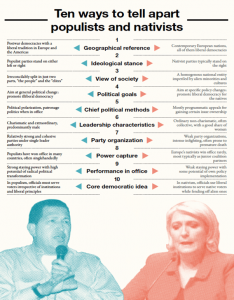
The lecturer argues that when populist parties come into office they tend to stay in office for many years, while attempting constitutional changes in effect replacing the liberal constitution with an illiberal one. The difference with the nativist parties is that they do not intend to change the (liberal) constitution. In Europe, these parties have so far not managed an outright majority and have only been in power through coalition governments.
Prof. Pappas listed some of countries were populist parties won office, amongst which are Greece (since 1980), Italy (since 1990), Hungary (since 2010), Poland (since 2015), the USA (in 2017), Mexico (since 2018) and Brazil (since 2018).
As previously mentioned, when populist come to power, they try to change the constitution. In some cases, they succeed, in others, they fail. In the infographic below you can see the major populist and nativist parties that, according to Dr. Pappas’ research, endanger liberal democracy.
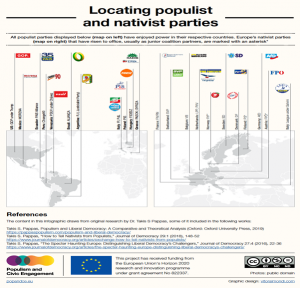
Source : https://pappaspopulism.com/populism-nativism-infographic/
To better understand the political parties in Europe prof Pappas proposes the following classification, dividing parties into two main groups : democratic and nondemocratic.
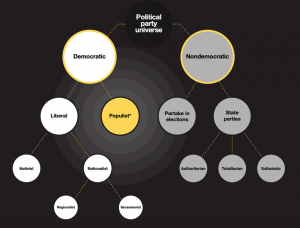
Source: https://pappaspopulism.com/category/nativism/
According to Prof Pappas, we can successfully located all political parties, irrespective of time, geographical space or political circumstance, in the simple “map”.
Using this overview, Prof. Pappas demonstrates the political landscape in today’s democratic Europe. He claims that in Europe there are no more than six or seven types of parties. We will find liberal democratic, populist, nativist, nationalist, regionalist and secessionist, antidemocratic parties.
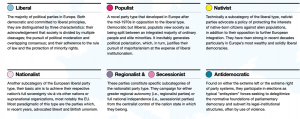
Source : https://pappaspopulism.com/populism-nativism-infographic/
A typology of parties in Europe. Blue refers to liberal, yellow to nativist, and magent to populist political parties.
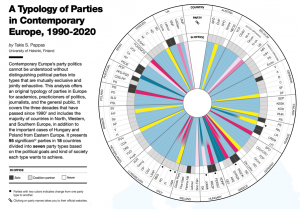
Source : https://pappaspopulism.com/populism-nativism-infographic/
In his lecture, Prof. Pappas introduced the audience to is “typology of parties” wheel. The wheel comprises 19 significant parties in 18 countries divided into seven party types based on the political goals and kind of society each type wants to achieve. In terms of historical evolution, the wheel was largely blue (liberal) until about 1990.
Prof. Pappas underlines that the infographic gives us a very dynamic idea of the forces of liberal democracy, where it is moving towards and what happened with the opponents of liberal democratic parties, both populist and nativist parties.
Outcomes
What can we learn form that? Prof. Pappas summarized several key takeaways from his lecture.
- Europe’s liberal democracy is still strong, but fragile. The only countries in Europe in which we currently have exclusively liberal, democratic parties (thus not nativist and not populist) are Portugal, Ireland and Luxembourg. In other countries in Europe, a mixture of liberal, populist and nativist parties exists. That was not the case some 20-30 years ago. The European Union was meant to be a union of countries with liberal governments and we have since its establishment seen an increase in parties on the nativist and populist flank.
- The enemies of liberalism are populism, autocracy, nativism. These are the biggest threats of liberal democracy.
- Populist parties are strong in Southern and Eastern parts of Europe. We see a lot of populist parties in Eastern Europe, particularly in Poland, Hungary, and the Czech Republic. In the last twenty years there have also been a strong presence of populist parties in Greece, Italy and Spain.
- When populists come to power, they usually rule singlehandedly. There is one exception- Spain, where the current government consists of a liberal party (PSOE , Spain’s socialist party) together with a populist party (Podemos, a left wing populist party). Usually, however, when populists come to power, they rule by themselves, and they stay in power for many years.
- Nativist parties are strong almost everywhere in Western and Northern Europe (From Norway to France).
- No nativist parties have ever come to power singlehandedly. There are only three cases in the EU where nativist parties have been in office as junior coalition partners- Austria, Finland, and Italy. In all those cases, the governments did not last very long. They were not successful governments.
- Strong antidemocratic parties are almost non-existent in today’s Europe. They do exist but they are not very strong.
- Europe is now faced with having to deal with anti-democratic, “rogue” states. There was a time, not long ago, when Europe was a collection of liberal states, and an ally of a liberal United States. There was a sort of attraction to liberalism, with other countries wanting to “join the club”. Turkey, for instance, had its eyes set on becoming an EU member. Hopes for a liberal Russia were also present, at least up until then occupation of Crimea. The same thoughts appeared about the Middle East after the Arab spring. There was excitement about the Arab spring, however bad the results have turned out to be.
Europe today as an adherent of democratic liberalism is, in a sense, standing alone. The number of antidemocratic “rogue states” includes Russia, Turkey and other Middle Eastern countries. With Brexit one of the most liberal nations in Europe has left the EU.
About Prof. Takis S. Pappas.
Takis S. Pappas is a scholar of political science. He has done research on populism, democracy, and political leadership. Presently, prof. Pappas is a docent and associate researcher at the University of Helsinki, Finland, working within the EU funded Horizon 2020 project “Populism and Civic Engagement” (PACE). His latest book Populism and liberal democracy provides an exquisite and concise analysis on the notion of populism, and how it threatens liberal democracy.
To learn more about democracy, populism, nativism and other important topics please visit prof. Pappas’ blog.












